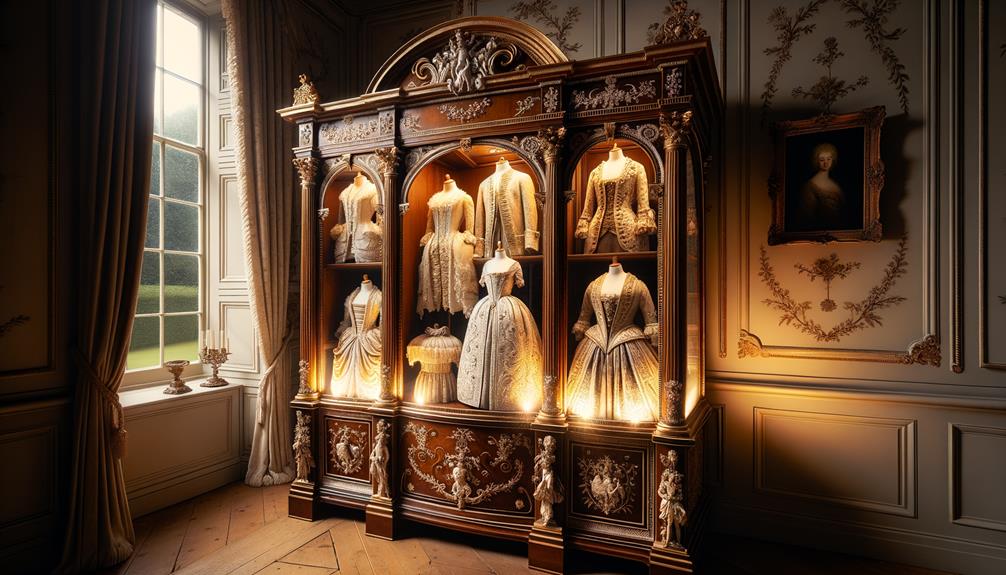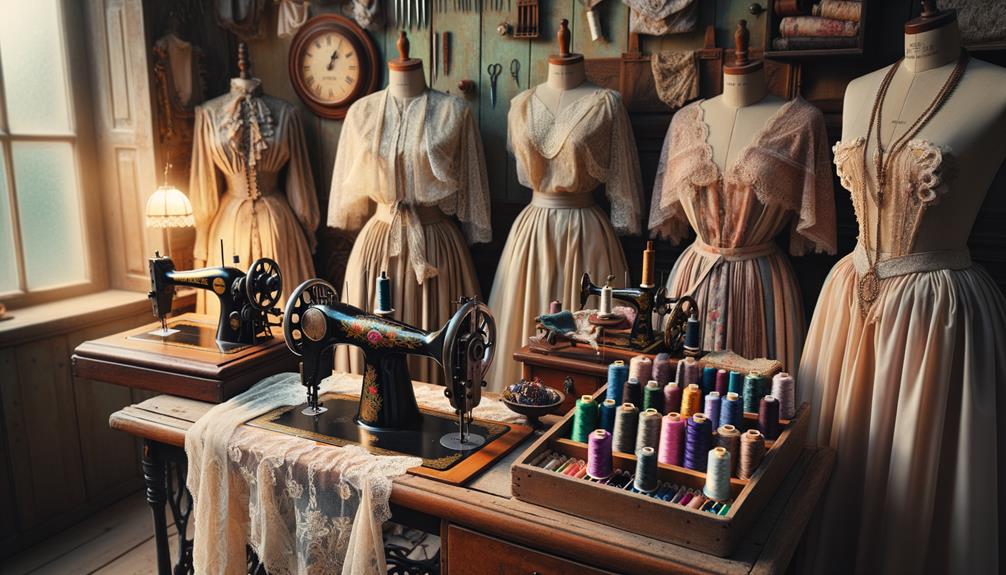When caring for my vintage clothing, I handle each piece with great care. I gently hand-wash them using a mild, pH-neutral detergent, and tackle any stains early on. I prefer using cotton or muslin garment bags and acid-free boxes lined with tissue paper to shield them from the environment. Wire hangers are a no-go – I opt for padded hangers or carefully fold delicate knits instead. The storage space needs to be dark and climate-controlled, with temperatures between 65-70°F and humidity levels around 40-50%, to preserve these treasures. I regularly inspect the items and address even minor signs of wear. For those wanting to cherish these heirlooms, proper preservation is key to protecting their stories.
Cleaning Vintage Garments
Cleaning vintage garments requires a gentle touch and a lot of patience to preserve their timeless beauty. Each piece has a unique story, and ensuring its longevity demands meticulous care. I always hand wash these delicate fabrics using a mild, pH-neutral detergent. This careful approach avoids the damage that harsh chemicals can inflict. Before immersing the garment, I meticulously spot clean any stains or soils. This step is crucial because it prevents the stains from setting further during the washing process.
Agitation and hot water can cause irreversible damage, so I handle each item with great care, avoiding any aggressive scrubbing or twisting. After washing, I air dry the garments. This method not only prevents shrinkage and fading but also safeguards the delicate fibers from the harsh conditions of a machine dryer.
For pieces that are particularly fragile or historically significant, I seek out a reputable dry cleaner who specializes in vintage textiles. Entrusting these treasures to professionals guarantees they receive the specialized care they deserve. By following these meticulous cleaning steps, I can ensure these garments continue to tell their stories for years to come.
Choosing Storage Materials
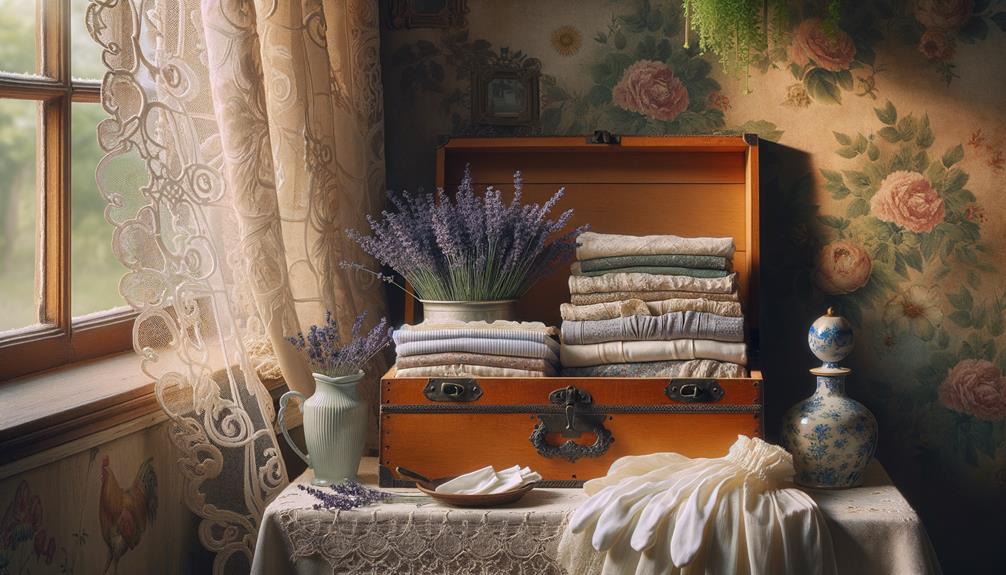
Selecting the right storage materials is key to preserving vintage clothing. As I've delved into the world of vintage preservation, I've come to appreciate the nuances of the materials that cradle these garments. Avoiding plastic bags or containers, which trap moisture, is a must. Instead, I turn to cotton muslin or unbleached muslin garment bags, which allow fabrics to breathe, preventing mildew and decay.
When it comes to hangers, wooden hangers are a sophisticated choice, but they must be padded to distribute weight evenly and avoid unsightly wrinkles. Wire hangers, which can rust and discolor fabric, are a definite no-go. For delicate or beaded treasures, acid-free boxes lined with acid-free tissue paper are indispensable. These boxes shield garments from the harmful acidic compounds found in regular cardboard, preserving their delicate fibers.
Knits, with their tendency to stretch, are best folded or gently rolled, providing a safeguard against gravity's relentless pull. Similarly, heavy or intricate fabrics should find solace lying flat or softly rolled, maintaining their form and preventing unwanted creases. Embracing these pH neutral, innovative storage solutions ensures each vintage piece remains a testament to its era's craftsmanship.
Packing Techniques
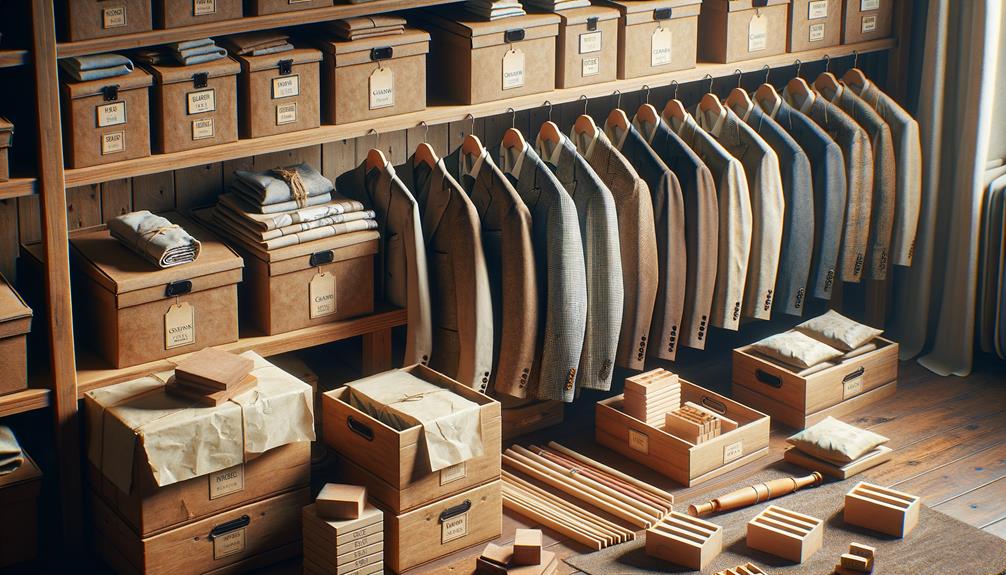
Packing vintage clothing requires a careful balance between preserving the garments and making them practical to store. Wrapping delicate items in acid-free tissue paper or muslin creates a gentle barrier, safeguarding the intricate weaves of natural fibers. It's crucial to avoid airtight plastic and cardboard boxes, as they can trap moisture and lead to deterioration. Instead, I carefully place each piece in acid-free archival-quality boxes, shielding them from light and fluctuating temperature and humidity.
For garments with more structure, like jackets and dresses, I stuff the sleeves and shoulders with acid-free tissue. This helps maintain their shape and prevents distortion over time. I never use wire hangers, as their sharp edges can cause irreversible damage. Wooden hangers aren't ideal either, as they can leach acids. Instead, I opt for padded hangers encased in acid-free covers, providing gentle support without compromising the fabric's integrity.
Light and Temperature Control

After meticulously packing each garment, I must also protect them from the potential threats of light and temperature. The charm of vintage clothing lies not just in its history but in its delicate fabric and colors, which can be vulnerable to the effects of light and heat. To properly store these treasures, I've learned that keeping them in a dark, cool, and climate-controlled area is crucial.
Exposure to light, especially sunlight, can cause fading and discoloration over time. As a result, I choose opaque boxes or cover the garments in breathable muslin rather than plastic, which can trap moisture and lead to mildew. Ensuring a stable environment is equally vital. Drastic temperature fluctuations can wreak havoc on textiles, accelerating their deterioration. I rely on air conditioning to maintain a consistent temperature between 65-70°F and relative humidity between 40-50%.
In this carefully curated space, each vintage piece can rest flat, undisturbed by the harsh elements. It's more than just storage; it's a haven for history. By controlling light and temperature, I preserve the integrity and timeless appeal of my collection for future generations to appreciate.
Regular Monitoring and Maintenance
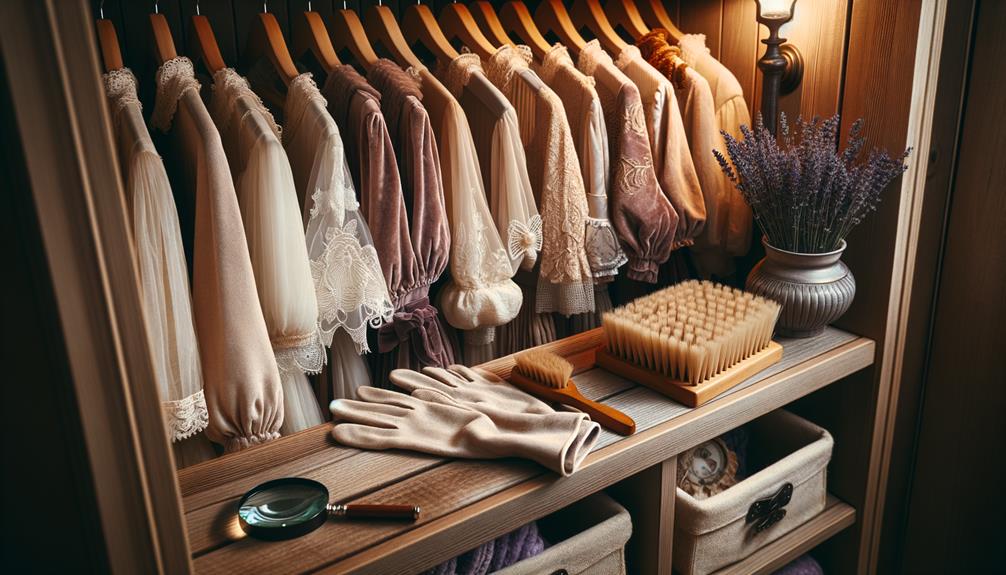
To keep my vintage clothing in excellent condition, I regularly inspect each piece for signs of wear and closely monitor the storage environment. Every item I store, whether it's an antique gown or a delicate lace shawl, undergoes a thorough examination to spot any stains, tears, or discoloration. Even minor issues can worsen over time if left unchecked.
Storing vintage garments requires controlling the temperature and humidity, which should ideally be between 65-70°F and 40-50% relative humidity. This vigilance helps prevent mold and mildew, which can be devastating. I also rotate the garments periodically, refolding or repositioning them to avoid permanent creases.
Handling antique textiles requires a gentle touch. I avoid using cardboard boxes, which can release acids harmful to fabrics, and instead use archival storage solutions. Regular handwashing of items that can handle it, using methods suited to vintage clothing, keeps them fresh without damaging the fibers.
Frequently Asked Questions
What Is the Best Way to Store Old Clothes?
Storing old clothes the right way is key to preserving their condition. Acid-free materials like archival boxes or breathable garment bags are ideal. Maintaining a consistent, cool temperature and low humidity level in the storage area can also help protect delicate fabrics. Avoid using hangers for items like lace or silk, as they can cause creases and damage over time. Before storing, ensure everything is clean and free of stains or dirt. Regularly check on your stored items and refold them to prevent permanent creases. This simple routine can go a long way in keeping your cherished clothes in top shape for years to come.
How to Store Historical Clothing?
Preserving historical clothing requires a delicate touch. I use acid-free materials to carefully store each piece, avoiding folds that could damage their appearance. Regular inspections and professional care are essential rituals to honor their legacy. A cool, dry, and dark space provides the ideal sanctuary to protect these fragile artifacts from the elements. By meticulously maintaining these garments, I'm able to ensure their stories live on for generations to come.
What Is the Best Way to Store Vintage T-Shirts?
Vintage t-shirts are a treasure to preserve. The best way to store them is by folding them loosely and laying them flat in acid-free boxes with tissue paper. This helps maintain their vintage charm. Be sure to keep them in a cool, dark place to prevent fading or damage. This simple storage method ensures your prized vintage tees stay in top condition for years to come.
How Do You Maintain Vintage Clothes?
Caring for vintage clothes takes dedication. I clean them thoroughly, using acid-free materials for storage, and keep them in a cool, dark space. Regular inspections and gentle handling help these timeless pieces stay vibrant and intact.
Conclusion
Vintage clothing is a treasure trove of history. To keep these timeless pieces pristine, proper cleaning, storage materials, and packing techniques are vital. Controlling light and temperature is crucial, like guarding a precious heirloom. Regular inspections are key to maintaining the integrity of these garments. It's not just about storage – it's an act of preservation, a connection to the past. The joy of seeing these garments remain perfect is truly rewarding.



